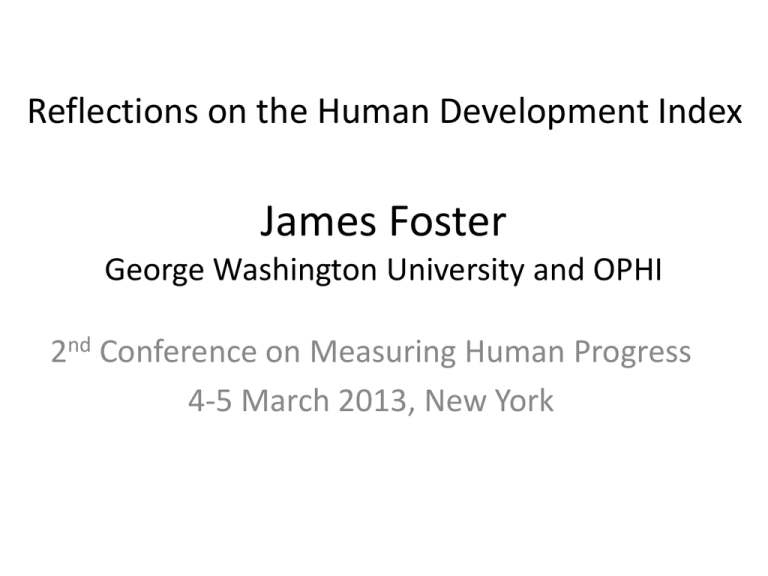James Foster - Human Development Reports
advertisement

Reflections on the Human Development Index James Foster George Washington University and OPHI 2nd Conference on Measuring Human Progress 4-5 March 2013, New York Introduction • HDI – Remarkable accomplishment – Attracted criticism • Arbitrary decisions • Purpose of this short talk – Focus on aspects of HDI that might be improved – Consider alternatives – Offer suggestions • View as less arbitrary Desiderata (Ia) It must understandable and easy to describe (Ib) It must conform to a common sense notion of what is being measured (II) It must fit the purpose for which it is being developed (III) It must be technically solid (IVa) It must be operationally viable (IVb) It must be easily replicable Desiderata • (I) corresponds to strong policy needs – Understandable at a deeper level including cutoffs – Measuring absolute size of HD • Atkinson’s independence of other countries – not relative – Anchored in underlying variables – Numbers mean something • (II) concerns the intended purpose of the measure – – – – Compete with GNI per capita Compare HD achievements across countries Monitoring progress across time for a given country Drilling in or out (subgroups or dimensions) Desiderata • (III) is is theoretical justification – Axioms to make sure measure conforms to purpose – Theoretical framework (say within welfare economics) • (IV) concerns practicality – Does it work with existing data? – Can it be updated in time? • These are benchmarks to compare and evaluate particular versions of HDI • Contrast with GNI per capita – Poor in (II), better in others? Outline of Paper • Reconsider frequent recalibration of top and bottom goalposts – Confounds understanding over time – Gives countries unclear signals • Reconsider HDI demarcations into relative groups – Purely relative to deflect criticism – But ends up deflecting incentives • Reconsider functional form – New geometric has certain characteristics – Old arithmetic has others – Which is best? Outline of Paper • Other themes – How to anchor HDI values • Through normalized variables or through original variables? – Purely data driven goalposts • Cause much confusion • Ought to have firm normative basis • Not just a (relative) function of observed achievements – Differentiate purposes of goalposts • Upper (aspiration) vs. lower (natural zeroes) • Lower should stay fixed • Upper may change periodically – Are irrelevant for new HDI, can be made so for old Lower Goalposts: Natural Zeroes • Fixed natural zeroes – Why should they change over time? – Conflicts with description of HDI as measure of absolute size – Need to satisfy measurement properties – Analogous to poverty cutoff for countries • Desiderata – Needed for measure to be simple and easy to explain – Needed to conform to measurement of HD – Fits purpose to compare over time and space Understanding the HDIs • Gist in 2-dimensional graphs – From original variables – To bottom normalized data (net variables) • Each measured from natural zeroes Original Variable 2 Original Variables natural zero natural zero Original Variable 1 Net Variable x2 0 0 Net Variables Net Variable x1 Upper Goalposts: Aspiration Levels Net Variable x2 Aspiration level 0 0 Aspiration level Net Variable x1 New HDI Net Variable x2 Wx = x11/2 x21/2 Aspiration level x WA Wx 0 0 Aspiration level Net Variable x1 New HDI Net Variable x2 HDIN = Wx/WA Aspiration level x WA Wx 0 0 Aspiration level Net Variable x1 New HDI Net Variable x2 HDIN = Wx/WA Aspiration level x WA Wx 0 0 Aspiration level Net Variable x1 New HDI Net Variable x2 HDIN = Wx/WA Only uses reference level WA x WA Wx 0 0 Net Variable x1 Functional Form • HDIN can be viewed as a social evaluation function of net variables, normalized by a reference level. – No need for upper goalposts or aspiration levels • But can use to set reference level – New ref level yields a multiple of previous HDIN • Same rankings • Same rates of growth • Other convenient properties Functional Form • HDIO: Arithmetic mean is used – But exactly how? – Return to graph Upper Goalposts: Aspiration Levels Net Variable x2 Aspiration level 0 0 Aspiration level Net Variable x1 Upper Goalposts: Aspiration Levels Net Variable x2 Set the slope of HDIO indifference Aspiration level 0 0 Aspiration level Net Variable x1 Upper Goalposts: Aspiration Levels Net Variable x2 Set the slope of HDIO indifference Aspiration level 0 0 Aspiration level Net Variable x1 Upper Goalposts: Aspiration Levels Net Variable x2 What if aspiration levels change? Aspiration level 0 0 Aspiration level Net Variable x1 Upper Goalposts: Aspiration Levels Net Variable x2 What if aspiration levels change? Slopes change - inconsistent Aspiration level 0 0 Old New Aspiration level Aspiration level Net Variable x1 Upper Goalposts: Aspiration Levels Net Variable x2 Always? Aspiration level 0 0 Aspiration level Net Variable x1 Upper Goalposts: Aspiration Levels Net Variable x2 Slope unchanged if new levels are proportionate Slope unchanged if new levels are proportionate Aspiration level 0 0 Aspiration level Net Variable x1 Upper Goalposts: Aspiration Levels Net Variable x2 HDIO = Wx/WA Aspiration level 0 x Wx 0 Aspiration level WA Net Variable x1 Functional Form • HDIO can be viewed as a social evaluation function of net variables, normalized by a reference level – if aspiration levels stay in proportion – New ref level yields a multiple of previous HDIO • Same rankings • Same rates of growth • Other convenient properties Summary of Suggestions – Leave natural zeroes as natural zeroes – Alter aspiration levels only infrequently • 5 – 10 years normative targets • In a constrained way (or proportionate) • All past inconsistencies will then be caused by data updates – Not by HDRO Summary of Suggestions – Fix absolute demarcation cutoffs for categorizing countries • Alternative 1: choose relatively, then fix absolutely • Alternative 2: Look within variables for natural cutoffs – Note: They will be arbitrary • Like poverty lines, like middle class ranges • But if fixed over time, countries can progress • And given above recalibration methods – Consistent cutoffs can be maintained over time Summary of Suggestions – Go back to original arithmetic formula • With fixed zeroes • With aspirations cutoffs constrained and updated infrequently – Normative, not positive Summary of Suggestions – Why arithmetic? • • • • Simple and understandable With above calibrations, similar properties to HDIN Decomposability by dimension (as in MPI) Potential for decomposability by subgroup if data permits » Mean of log individual incomes » Rather than log of mean incomes Summary of Suggestions – What about inequality across dimensions? • HDIN accounts for it • HDIO does not – Note the Atkinson Inequality measure: IA = (HDIO – HDIN)/HDIO • But this form of inequality is not the priority! • Within dimension inequality is key! – Focus: Need data to move to IHDI as the standard Summary of Suggestions – Alternative transformations for variables? • Careful to maintain simplicity! • Chakravarty: HDI0 form but with all variables transformed by a common concave function • Of course this is possible – Simplicity? Lose the close connection between variable and measure – it is a function of the normalized variable! » But can decompose by dimension – No possibility for subgroup decomposition » Even if alter data – Why transform income and others identically? Thank you!








